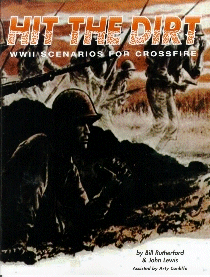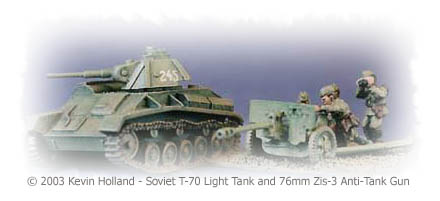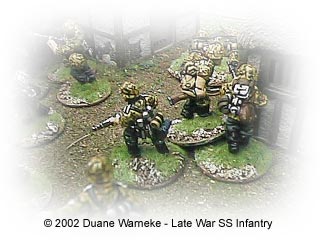 |











 Crossfire Review
Crossfire Review
 Tactical
Advice
Tactical
Advice
 Identifying Units
Identifying Units
 Tips for the
Novice
Tips for the
Novice
|
 |
 |
 |
 |
 |
 |
The Crossfire scenario supplement by Bill
Rutherford and John Lewis When
Arty Conliffe approached me about writing a scenario book for his rule
set CROSSFIRE I was quite elated. John Lewis (my co-author) and I had
already put many enjoyable hours into learning and playing CROSSFIRE.
Most of our games revolved around pre-generated scenarios so it seemed
a natural thing to properly research and document what we were already
doing and to incorporate it all into a coherent whole - the work you
are now reading.
 John and I
initially wanted to do scenarios covering all of World War II in all
of its theaters. We quickly realized that this was not to be - there
are simply too many good "scenario opportunities" for a single book -
or several such! We decided, then, to limit ourselves to introducing
the various campaigns in Europe, from the beginning of Barbarossa
until VE Day. We've included eight scenarios each from the Eastern
Front and the Western Front, and five from the Italian Campaign.
Rather than break them out by theater, we presented them
chronologically. If you simply must know how things turned out without
wading through most of the war in Europe, go directly to Scenario 21,
"Race for the Reichstag", with the compliments of Chris Leach! John and I
initially wanted to do scenarios covering all of World War II in all
of its theaters. We quickly realized that this was not to be - there
are simply too many good "scenario opportunities" for a single book -
or several such! We decided, then, to limit ourselves to introducing
the various campaigns in Europe, from the beginning of Barbarossa
until VE Day. We've included eight scenarios each from the Eastern
Front and the Western Front, and five from the Italian Campaign.
Rather than break them out by theater, we presented them
chronologically. If you simply must know how things turned out without
wading through most of the war in Europe, go directly to Scenario 21,
"Race for the Reichstag", with the compliments of Chris Leach!
These scenarios were all designed with CROSSFIRE in mind. The orders
of battle, however, can all be adapted with little or no effort to
other games using the squad as the basic maneuver element. Though
CROSSFIRE specifies no ground scale, one could safely assume any of
the battle maps presented herein to measure approximately 500 meters
(give or take 100 meters - but who's counting?) to a four foot map
edge.
When researching the scenarios we focused less on ensuring that every
scenario represented an historical milestone in the history of
infantry combat and more on finding enjoyable, gameable scenarios.
People read the former; they play the latter. Though we tried hard to
achieve a modicum of accuracy in our orders of battle and terrain, we
cheerfully altered scenario details, when required, for the sake of
the game. Generally we commented on our more egregious changes in the
scenarios' notes. As has been writ elsewhere, these scenarios do not
put you in the Company Commander's shoes to change history. They do
give you a variety of frameworks for enjoyable games.
 We tried to
make our maps reasonably clear and consistent with the CROSSFIRE
terrain types. In a couple of cases, new terrain types - or treatments
- were necessary and we address those cases in the special rules or in
the scenario rules. A short terrain key appears elsewhere on this
page. We didn't use any particular terrain system in designing the
scenarios - we play locally using Geo-Hex, foam hills, cloth forests
(with trees on them), corduroy fields, etc., as available. Due to the
scale of the scenarios, the nature of CROSSFIRE, and the wide variety
of scenery materials available, players will likely alter the
scenarios' terrain - either accidentally or on purpose. This should
not adversely affect play as long as a couple of principles are
adhered to. Be suspicious of lines of sight (LOS). If there's a long
LOS on a scenario map it probably belongs there. Don't create them
where they don't exist, either. Key terrain features - buildings,
bridges, etc., should not be moved more than necessary. Typically
they're objectives or have other significant impact on the scenario.
Of course, if you move them and they change the course of your game,
that's not altogether bad as long as a good game results! We tried to
make our maps reasonably clear and consistent with the CROSSFIRE
terrain types. In a couple of cases, new terrain types - or treatments
- were necessary and we address those cases in the special rules or in
the scenario rules. A short terrain key appears elsewhere on this
page. We didn't use any particular terrain system in designing the
scenarios - we play locally using Geo-Hex, foam hills, cloth forests
(with trees on them), corduroy fields, etc., as available. Due to the
scale of the scenarios, the nature of CROSSFIRE, and the wide variety
of scenery materials available, players will likely alter the
scenarios' terrain - either accidentally or on purpose. This should
not adversely affect play as long as a couple of principles are
adhered to. Be suspicious of lines of sight (LOS). If there's a long
LOS on a scenario map it probably belongs there. Don't create them
where they don't exist, either. Key terrain features - buildings,
bridges, etc., should not be moved more than necessary. Typically
they're objectives or have other significant impact on the scenario.
Of course, if you move them and they change the course of your game,
that's not altogether bad as long as a good game results!
The bibliography lists only those sources that directly contributed to
our scenarios. Numerous other books (including several good war
novels) provided us with inspiration and general background
information but didn't make it into the bibliography simply due to
space constraints.
We make no recommendations about using a referee in any but one of the
scenarios because most of us want to play, not adjudicate gamer
disputes. Though not required in any of the scenarios, a referee can
prove useful in several ways, including varying indirect fire
ammunition loads, placing barbed wire and obstacles, etc.
 Your questions and comments are welcome. The special rules worked for
us - how'd they work for you? Your questions and comments are welcome. The special rules worked for
us - how'd they work for you?
Enjoy! - Bill Rutherford
Acknowledgments
As is usual with this sort of thing, HIT THE DIRT is not the product
solely of John Lewis' and my efforts. Thanks must go to a number of
people without whom these scenarios would never have seen light of
day. Johnson Hood, of Wargames Inc, made the entire effort possible.
Arty Conliffe gave John and me the chance to make something of this
opportunity. Chris Leach provided (on his phone bill!) valuable rules
feedback and even provided a scenario. Arturo Fillipo Lorioli provided
information on the Italian Army in Sicily that we'd simply never have
found otherwise. Charles C. Sharp did likewise for the Soviet Army -
both in his books (see the bibliography) and in a couple of rather
chaotic meetings, complete with documentation, held at HMGS
conventions. The local gang of gamers, including (in no particular
order) Russ Jenson, Scott Thompson, Victor Graulau, John Drye, Tom
Lutke, and others, helped play one or more of the scenarios to ensure
their playability - and inveterate tinkerers that they are, provided a
host of suggestions to help the rules (and scenarios) play even
better. Thanks to one and all!
All of the maps contained in HIT THE DIRT were produced using Campaign
Cartographer 2, a simple-to-use game mapping program. A number of the
building symbols were taken, with permission, from Phillip Rhodes'
symbols catalog (I promised I'd make him famous by naming him),
available from the Campaign Cartographer website at
www.profantasy.com.
You may reproduce any of these maps for your personal use in playing
the scenarios in HIT THE DIRT.
 Hit
the Dirt - Table of Contents
 Green Hell
Green Hell
29 June 1941
 Breakout at the Hinge
Breakout at the Hinge
25 July 1941
 Assault on Tula
Assault on Tula
29 October 1941
 Battle for the Highway
Battle for the Highway
9 April 1942
 The Island
The Island
25 August 1942
 Battle for Ponyri
Battle for Ponyri
6 July 1943
 Roadblock on Highway 120
Roadblock on Highway 120
20 July 1943
|
 Dung Farm
Dung Farm
4 February 1944
 Cassino Massif
Cassino Massif
4 February 1944
 Reconnaissance Before Pontecorvo
19 May 1944
Reconnaissance Before Pontecorvo
19 May 1944
 Breakout from Mogilev
Breakout from Mogilev
27 June 1944
 Scottish Corridor
Scottish Corridor
28 June 1944
 Bocage
Bocage
11 July 1944
 Monte Altuzzo
Monte Altuzzo
14 September 1944
|
 Deadman's Moor
Deadman's Moor
22 September 1944
 Hotel Brittania
Hotel Brittania
3 November 1944
 Germans in the Woods
Germans in the Woods
17 December 1944
 Sadzot
Sadzot
28 December 1944
 Battle for Hardt
Battle for Hardt
28 February 1945
 Debacle at Hitdorf
Debacle at Hitdorf
6 April 1945
 Race for the Reichstag
Race for the Reichstag
30 April 1945
|
|

|


|
 |
 |
|

[ Home ] [ Introduction ] [ Review ] [ Hit The Dirt ] [ FAQ & Articles ] [ Reichstag ] [ More Crossfire ] [ More Research ] [ Gallery ] [ Wally Simon ] [ Wargaming.info ]
The CROSSFIRE Website is edited and maintained
by John Moher. Additional contributions were made by John Kovalic, Luca Fazio,
and William Scarvie III. CROSSFIRE is © 1996 Arty Conliffe. The contents of
these pages are © 1996-2009 John Moher, Arty Conliffe, Rob Wolsky, Bill
Rutherford, and/or the appropriate Authors and Contributors.
|
|
 |
![]() Crossfire Review
Crossfire Review![]() Tactical
Advice
Tactical
Advice![]() Identifying Units
Identifying Units![]() Tips for the
Novice
Tips for the
Novice

 John and I
initially wanted to do scenarios covering all of World War II in all
of its theaters. We quickly realized that this was not to be - there
are simply too many good "scenario opportunities" for a single book -
or several such! We decided, then, to limit ourselves to introducing
the various campaigns in Europe, from the beginning of Barbarossa
until VE Day. We've included eight scenarios each from the Eastern
Front and the Western Front, and five from the Italian Campaign.
Rather than break them out by theater, we presented them
chronologically. If you simply must know how things turned out without
wading through most of the war in Europe, go directly to Scenario 21,
"Race for the Reichstag", with the compliments of Chris Leach!
John and I
initially wanted to do scenarios covering all of World War II in all
of its theaters. We quickly realized that this was not to be - there
are simply too many good "scenario opportunities" for a single book -
or several such! We decided, then, to limit ourselves to introducing
the various campaigns in Europe, from the beginning of Barbarossa
until VE Day. We've included eight scenarios each from the Eastern
Front and the Western Front, and five from the Italian Campaign.
Rather than break them out by theater, we presented them
chronologically. If you simply must know how things turned out without
wading through most of the war in Europe, go directly to Scenario 21,
"Race for the Reichstag", with the compliments of Chris Leach! We tried to
make our maps reasonably clear and consistent with the CROSSFIRE
terrain types. In a couple of cases, new terrain types - or treatments
- were necessary and we address those cases in the special rules or in
the scenario rules. A short terrain key appears elsewhere on this
page. We didn't use any particular terrain system in designing the
scenarios - we play locally using Geo-Hex, foam hills, cloth forests
(with trees on them), corduroy fields, etc., as available. Due to the
scale of the scenarios, the nature of CROSSFIRE, and the wide variety
of scenery materials available, players will likely alter the
scenarios' terrain - either accidentally or on purpose. This should
not adversely affect play as long as a couple of principles are
adhered to. Be suspicious of lines of sight (LOS). If there's a long
LOS on a scenario map it probably belongs there. Don't create them
where they don't exist, either. Key terrain features - buildings,
bridges, etc., should not be moved more than necessary. Typically
they're objectives or have other significant impact on the scenario.
Of course, if you move them and they change the course of your game,
that's not altogether bad as long as a good game results!
We tried to
make our maps reasonably clear and consistent with the CROSSFIRE
terrain types. In a couple of cases, new terrain types - or treatments
- were necessary and we address those cases in the special rules or in
the scenario rules. A short terrain key appears elsewhere on this
page. We didn't use any particular terrain system in designing the
scenarios - we play locally using Geo-Hex, foam hills, cloth forests
(with trees on them), corduroy fields, etc., as available. Due to the
scale of the scenarios, the nature of CROSSFIRE, and the wide variety
of scenery materials available, players will likely alter the
scenarios' terrain - either accidentally or on purpose. This should
not adversely affect play as long as a couple of principles are
adhered to. Be suspicious of lines of sight (LOS). If there's a long
LOS on a scenario map it probably belongs there. Don't create them
where they don't exist, either. Key terrain features - buildings,
bridges, etc., should not be moved more than necessary. Typically
they're objectives or have other significant impact on the scenario.
Of course, if you move them and they change the course of your game,
that's not altogether bad as long as a good game results! Your questions and comments are welcome. The special rules worked for
us - how'd they work for you?
Your questions and comments are welcome. The special rules worked for
us - how'd they work for you?